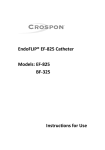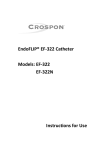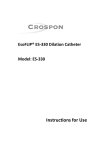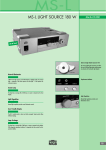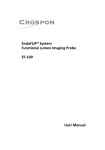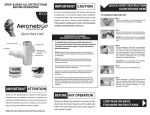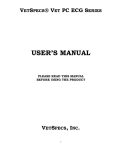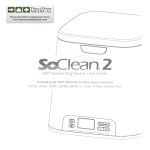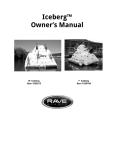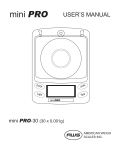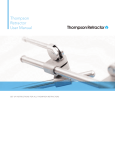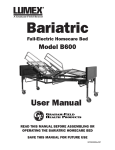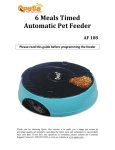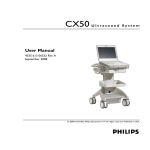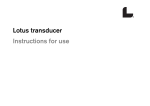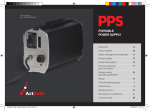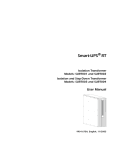Download EndoFLIP® EF-620 Catheter Models: EF
Transcript
EndoFLIP® EF-620 Catheter Models: EF-620 Instructions for Use Table of contents 1. 2. Introduction ........................................................................................ 3 1.1 How it works ................................................................................. 3 1.2 Intended Use ................................................................................. 4 1.3 Contraindications .......................................................................... 4 1.4 Warnings ....................................................................................... 4 Using the catheter ............................................................................... 5 2.1 Installing the catheter assembly ................................................... 5 2.2 Placing the catheter to measure Gastric Sleeve diameter at different positions along the sleeve......................................................... 6 2.3 Testing the sleeve ......................................................................... 7 2.4 Disconnecting the catheter ........................................................... 8 Appendix A: Specifications ............................................................................ 9 Copyright © 2014 Crospon Ltd. This document is the sole property of Crospon Ltd. No part of this document may be copied or otherwise reproduced, or stored in any electronic information retrieval system, without the prior consent of Crospon Ltd. EndoFLIP®, EsoFLIP® and FLIP® are registered trademarks of Crospon Ltd. ii EndoFLIP® EF-620 Catheter Instructions for Use, DD-518 Rev B 1. Introduction The EndoFLIP® EF-620 Catheter is a single-use catheter that when connected to an EndoFLIP® unit displays estimates of the diameters at 16 points over a 160mm measurement area within the balloon. The outer diameter of the catheter shaft is 6mm. 1.1 How it works The EF-620 Catheter acts as a Functional Lumen Imaging Probe (FLIP) that shows dynamic changes in the geometry of the measurement area in a real-time image. The catheter connects to an EndoFLIP® System, which injects a conductive solution into the catheter balloon placed in the measurement area. The balloon contains an array of electrodes that measure voltage. The EndoFLIP® System uses these voltages to estimate the diameter at 16 points, 10 mm apart, along the measurement area (Figure 1). Refer to the EndoFLIP® system user manual for a further description of the system. Tissue Catheter Balloon inflated with conductive solution Estimated diameter (Dest) measured at each electrode (16 measurements, 10mm apart) Figure 1: EndoFLIP® EF-620 Catheter EndoFLIP® EF-620 Catheter Instructions for Use, DD-518 Rev B 3 1.2 Intended Use The EndoFLIP® EF-620 catheter is indicated for use as an adjunct to a bougie in measuring the size of a gastric sleeve created during bariatric surgery. It is suitable for diameter measurements for 22 to 60 French sleeves. Note: The EF-620 catheter is to be used only with the EndoFLIP® system. 1.3 Contraindications • • The EndoFLIP® System is contraindicated where endoscopy is contraindicated. • Do not use the EndoFLIP® System on patients with actively-bleeding varices in the esophagus. 1.4 The EF-620 catheter is not suitable for diameter measurements smaller than 22 French. Warnings • Do not reuse, reprocess, or re-sterilize. Reuse, reprocessing or re-sterilization can: compromise the structural integrity of the device; impair performance accuracy due to residual fluid in the balloon and degrade the catheter markings. • • • Federal law (U.S.) restricts this catheter to sale by, or on the order of, a physician. • To avoid damaging the catheter and syringe, store away from sources of heat in specified environmental conditions (see Appendix A: Specifications). • Before using the EndoFLIP® System and catheter on a patient, allow the device to acclimate to conditions of use following transport or storage. • During operation, check that the amount of fluid in the syringe matches the amount shown onscreen, and verify that the syringe refills as indicated when the plunger aligns with the arrow on the syringe (indicating that the balloon is empty) before carefully removing the catheter from the patient. • Verify that there are no leaks in the catheter during the pre-use purge cycle described in the EndoFLIP® System user manual. • Replace the catheter if a Dest value remains consistently at a maximum or minimum value compared to adjacent Dest values; this can indicate a faulty catheter. • • Remove the catheter if the patient requires defibrillation. 4 Follow all applicable Federal and local regulations for disposal or recycling. To ensure proper operation and to minimize the risk of patient injury, do not attempt to add or remove fluid from the supplied pre-filled syringes. Only use the pre-filled syringe supplied with the catheter. Note: Different catheter part numbers are supplied with different solution concentrations. Refer to the EndoFLIP® system user manual for warnings relating to use of the EndoFLIP®System. EndoFLIP® EF-620 Catheter Instructions for Use, DD-518 Rev B 2. Using the catheter This section describes how to install and use the EndoFLIP® EF-620 catheter. 2.1 Installing the catheter assembly Warning: Before use, inspect the catheter assembly from end to end for breakage, occlusions, or debris. Do not use if damage to the parts or packaging is evident or if any portion of the package has been previously opened. Do not use any part after its expiration date or if the expiry date cannot be verified. 1. Remove the single use catheter assembly from its packaging, remove the protective sheath from the balloon, and dispose of the sheath. 2. Wipe down the catheter with an alcohol swab. 3. Place the balloon, tip first, into the EndoFLIP® pre-use checkout tube which holds the balloon in a vertical position (see Figure 2). Catheter with the balloon inside the Preuse checkout tube. Pre-use checkout tube. Figure 2: EndoFLIP® catheter in the pre-use check-out tube. 4. Prepare the catheter for use as described in the EndoFLIP® System user manual, noting that the syringe connects to port A of the EF-620 catheter (See Fig 3 below). EndoFLIP® EF-620 Catheter Instructions for Use, DD-518 Rev B 5 2.2 Placing the catheter to measure Gastric Sleeve diameter at different positions along the sleeve Warning: Avoid using excessive force during insertion. Withdraw the catheter if resistance is too high. 1. 2. Apply lubrication to the catheter (if required) and insert transorally, until the tip of the catheter can been seen under laparoscopic visualization pressing against the sleeve wall. Guide the catheter down towards the pylorus, using a laparoscopic tool, if necessary, to push the catheter away from the greater curve towards the lesser curve of the stomach. If the catheter is difficult to advance, remove it and retry. Note: The markings on the catheter are measured from the most proximal measuring electrode in the balloon 0 Figure 3: EndoFLIP® EF-620 Catheter markings Zero Reference 3. 4. Hold or secure the catheter once it is properly positioned in the stomach, with the most proximal electrode positioned in the proximity of the gastroesophageal junction. Use the EndoFLIP® system to deliver 30ml of fluid from the syringe into the balloon, after which the sleeve diameter values can be observed on the EndoFLIP® screen. Note: The EndoFLIP® System with EF-620 catheter attached can be set to inflate up to a volume of 60 ml at flow rates of 20, 40, and 60 ml/min. 5. Check that the balloon is correctly located by pressing the stomach wall with a laparoscopic tool and observing the corresponding diameter reduction in the balloon. 6 EndoFLIP® EF-620 Catheter Instructions for Use, DD-518 Rev B 2.3 1. 2. Testing the sleeve A lumen is provided in the EF-620 catheter to inflate the sleeve to allow it to be leak tested. Should you wish to inflate the sleeve, connect a syringe to the luer port (Port B in Figure 4) and manually inflate the sleeve to the desired volume, observing the sleeve as it expands using direct laparoscopic visualization. Figure 4 shows two connection ports on the catheter. Port A is used for connecting to the saline filled syringe to fill the balloon. Port B is used for injecting air or methylene blue into the sleeve as a means of detecting leaks. Port A Port B Figure 4: Catheter Ports. Warning: In the unlikely event that the EndoFLIP® System stops normal operation during a procedure, use the back panel on/off switch to turn the unit off, remove the syringe from the unit and retract the syringe plunger manually to withdraw any remaining fluid from the balloon catheter. The catheter can then be carefully removed from the patient. Syringe returned to original position: plunger aligns with arrow Figure 5: Syringe returned to original position EndoFLIP® EF-620 Catheter Instructions for Use, DD-518 Rev B 7 2.4 Disconnecting the catheter Once the procedure is complete and the balloon is deflated (as described in the EndoFLIP® System user manual), carefully remove the catheter from the patient. Disconnect the catheter and syringe from the unit and check the structural integrity of the catheter. Warning: Single use device, follow all applicable Federal and local regulations for disposal or recycling of the syringe and catheter. 8 EndoFLIP® EF-620 Catheter Instructions for Use, DD-518 Rev B Appendix A: Specifications Operating and storage conditions Operating conditions Temperature 20 to 40 °C Humidity 15 to 95% relative humidity (noncondensing) Atmospheric pressure 700 to 1060 hPa Storage conditions Main label symbols Temperature 0 to 25 °C Humidity 10 to 95% relative humidity (noncondensing) Atmospheric pressure 500 to 1060 hPa Single-use device Storage temperature limits Use-by date Manufacturer Batch code EndoFLIP® EF-620 Catheter Instructions for Use, DD-518 Rev B 9 Part number Caution, consult accompanying documents CE Mark and Notified Body Number: product complies with requirements of the Medical Device Directive 93/42/EEC Date of Manufacture Rx ONLY Xn 10 Caution: Federal law restricts this device to sale by or on the order of a physician. Box contains quantity ‘n’ catheter(s). EndoFLIP® EF-620 Catheter Instructions for Use, DD-518 Rev B Catheter Specifications Manufacturer information Maximum Inflate Volume 60ml Maximum Inflate Rate 60ml/min Dest Measurement Range 7.33mm to 20mm Dest Measurement Accuracy ±1mm over measurement range. Crospon Ltd. Galway Business Park Dangan Galway Ireland Europe: Phone: +353-91-519880 Fax: +353-91-519889 email: [email protected] US: Phone: 1-855-CROSPON Fax: 760-406-5644 email: [email protected] EndoFLIP® EF-620 Catheter Instructions for Use, DD-518 Rev B 11 12 EndoFLIP® EF-620 Catheter Instructions for Use, DD-518 Rev B












